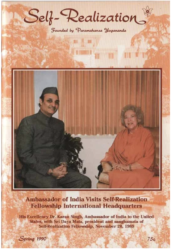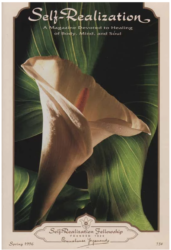Presented (just for fun) by Andy and Serafi
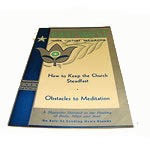
“In this world, we are all a little bit crazy, and we don’t know it, because crazy people of the same kind mix with the same kind of crazy people. When people differently crazy come together, then they find out about their own craziness.”
One inspired day, after having reflected on these words of Yogananda, Andy, a lively Ananda devotee, and Serafi, a devoted SRF-member, decided to come together to chat, finding out about their “craziness” by mixing with each other. The topic they decided to discuss was “The history of Yogananda’s magazines.”
The Guru had made another fun statement: “I sometimes think God must be watching in amazement this big zoo of human beings here.” Well, Andy and Serafi were two somewhat different “animals” of God’s big zoo, who perceived the world with very different eyes. So at first they examined each other doubtfully, but then happily sat down for a good cup of tea and a piece of cake. Soon they began appreciating each other’s company. Did they agree on everything? Hardly. But they were able to “agree to disagree,” as broad-minded people do.
So they began to study the old magazines. Serafi had brought an amazing stack of them, and Andy added a few as well. Their goal was to look carefully at the content and at the “feel” of the magazines, to get a better understanding of SRF at various points of its evolution. And truly, the beauty of the old magazines is that they convey the pulse and heartbeat of SRF at every point of its existence. Through them, one can almost intuit the life behind the monastic walls.
Thus immersing themselves, Andy and Serafi discovered a colorful panorama, a lively story, all highly interesting.
In the beginning, Serafi was confronted with a psychological difficulty: “I am so familiar with a certain way of knowing SRF, through decades of its publications, that it is hard to be open to a very different SRF of earlier times. One actually has to let go of all personal concepts about SRF to understand its past.”
Andy, by the way, had earlier discovered two websites which publish parts of the old magazines. But he quickly found out that as historical documents they are of little value, since they had been edited and revised, according to the taste of the publisher. Dhirananda, for example, a main player during the 20ies, who was much included in the early magazines, was entirely deleted. History should remain history, Andy thought, and not become part of organizational agendas.
Yogananda’s wrote a mission statement for this magazine, published in an introductory “Special Notice”:
“With this November-December 1925 issue, official organ of the YOGODA AND SAT-SANGA HEADQUARTERS at Mount Washington, Los Angeles, “˜East-West’ makes its initial bow to the American public. Its Aim and Purpose, as outlined by Swami Yogananda, is to inspire, to enlighten, and to encourage all to live the Practical Spiritual Life. We plan to fill all issues with articles, poems, pictures, and editorials of genuine wide appeal and interest.
So Andy and Serafi read and read, discussing magazines all day long. Andy took notes and later together they wrote up the following study.
Here the magazine’s history starts:
Yogananda came to the West in 1920, and soon began putting the printing-press to work, to get his mission started. Even before establishing Mt. Washington, he had already printed Songs of the Soul, the Yogoda Introduction, Science of Religion, and Scientific Healing Affirmations.
While on his “campaigning” tour through America in 1924, he felt the time was ripe for publishing a regular magazine.
It was in November 1924, while visiting his much-loved friend, the “American Saint” Luther Burbank in Santa Rosa, that the name of the new magazine was created.
We read in Autobiography of a Yogi:
“Luther,” I remarked, “next month I am starting a magazine to present the truth-offerings of East and West. Please help me decide on a good name for the journal.” We discussed titles for awhile, and finally agreed on “East-West.” After we had reentered his study, Burbank gave me an article he had written on “Science and Civilization.” “This will go in the first issue of East-West,” I said gratefully.”
Actually the first issues were called “East-West World Wide.” The addition of “World Wide”, as one reads, was Luther Burbank’s suggestion. But from January 1926 it was discontinued, maybe because “East-West” already implies the concept “World Wide”.
“Next month” Yogananda wanted to get the magazine out on the road. But Brother Time often seems to refuse the desire to move too quickly: the first issue of “East-West” finally came out a year later, in November 1925, just after Yogananda had dedicated his Mt. Washington headquarters. He kept his word: Luther Burbank’s article “Science and Civilization” was included in this maiden issue.
~~~
The Twenties
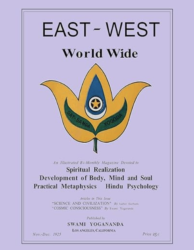
What did Yogananda want to accomplish with his magazine “East-West”?
- He saw that many devotees he had met in different cities would benefit from this constant contact and inspiration: “My blessings to all my students. I will talk to you all thru the columns of this magazine, and remember you each morning in my seven o’clock prayer, that you may persevere in your practice and know the supreme joy of absolute spiritual realization.”
- He also saw it as an instrument to share with all, as he wrote in the first issue, “universal principles for making life more beautiful.”
- His hope was: “Let our hunger for knowledge make us forget our minor differences and teach us to gladly receive the truth-offerings of others.” His openness and universality were keenly felt in these magazines.
- And of course he saw it as a way to unite East and West, for “making understood the different good traits of Eastern and Western life in general, through fellowship and constructive exchange of practical ideas (Sat-Sanga).” He wrote beautifully: “Let the East and West be ever ready to exchange the best in them and thus make life complete.” (All these quotes come from the first issue, describing the “Aims of East-West”)
Science was important in his magazine, which was a big contribution of the Western world. So were the arts: poetry, paintings, musical notations. They fairly abound in the magazines of these early years.
On the very first page in the first issue, readers were invited to write their own contributions, or photos, and send them in for the publisher’s consideration. The magazine was like an open field, so to speak, where all were invited to sow seeds of upliftment.
Here are the contents of the first issue, which is typical for that era of the magazine. Many different writers contributed.
- Dedication to Mrs. Mary E. Foster (who “made it possible to start and carry on this Magazine.”)
- Cosmic Consciousness, by Swami Yogananda
- When God Walked in My Garden (Poem), by Elisabeth Swaller
- Swami Yogananda’s Educational Work in India
- History of Swami’s Work in America
- Life’s Dream (Poem), by Swami Yogananda
- Formal Opening of Mt. Washington Center
- Science and Civilization, by Luther Burbank
- Greetings to Swami’s American Students
- Los Angeles Class (picture)
- Luther Burbank (Poem), by Swami Yogananda
- A Prayer, by a disciple
- The Balanced Life, by Swami Yogananda
- “Dusky Sound, ” New Zealand (Picture)
- Pantheism (Poem), by a disciple
- The Path that Leads to God, by Harriet Hobson
- Sayings of Swami
- Greetings to India
- Swami Dhirananda, by Swami Yogananda
- My Native Land (Poem), by Swami Yogananda
- This and That (Notes)
The second issue of “East-West” offered an article on Buddha, on Sufism, on Guru Nanak (the Sikh founder), and again three poems by various contributors, as well as a scientific contribution on “the World of Nature.” Dhirananda wrote a long article, and others. In that issue one also finds a nowadays un-published picture of Yogananda wearing a head band, which was given to him by Chief Yowlachie (1890–1966), a Native American from the Yakama tribe, and also a famous actor and opera singer, who visited Mt. Washington in Nov.1925.
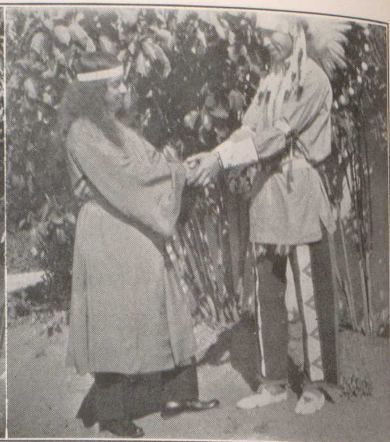
The magazine was published bimonthly.
These first magazines were bigger in size than today, and were somewhat rustic. Well, and of course this reflects perfectly the heartbeat of SRF (or better, Yogoda Satsanga) during these early years in the West: it was all very rustic and simple.
Kamala writes that when she came with her mother to stay at Mt. Washington in Summer 1926, their room was completely empty, unfurnished. They had to paint it too. The “building was scarcely occupied, and we had our choice of dozens of rooms.” Imagine the big empty house!
Durga Ma writes that still in Dec. 1929, when she moved in, “some of the rooms were furnished with the individual’s own furniture, and some were empty.” To her new room a bed and mattress was brought. Yogananda personally carried a rug into her new quarters. Later she went to buy a dresser, a chair, and a table at a second-hand store. Other devotees used orange crates with planks to hold their mattress up, “and more crates for dresser and shelves.” Only 15 or 16 devotees lived there at the time. Again, imagine the totally different scene. Life at Mt. Washington wasn’t monastic then, either. The building, which wasn’t in great shape when Yogananda bought it, was painted for the first time only in 1933 (see Durga’s book)! One gets the idea. Life was rustic!
In May/June 1926 East-West offered space for publicity in the magazine, stating that 5,000 magazines had been sold, and they ran out. For the next one therefore 10,000 would be printed. What a start!
It is probable that Laurie Pratt (Tara Mata) was the editor of the magazine from 1925-1929 (in 1929 she left, in 1936 she came back). From Nov. 1937 onwards, the magazine states Laurie Pratt to be its editor. In the meantime other persons filled that role: Salome Marckwardt, Louise Royston.
Yogananda was much gone traveling, “campaigning.” Often, so Daya Mata writes, he mailed his articles from the city where he was lecturing, even during his trip to India, via Europe and Palestine in 1935-36.
What is the over-all pulse and heartbeat of these early magazines? A free breath of inspiration. Openness. Youth.
~~~
The Thirties
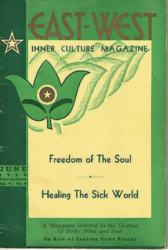
The Thirties began on a tough and rocky path. It was the period of America’s great economic crises. East-West had to pass through a terrible time. It got sick, so to speak, and lay in bed, unmoving. The printing-press stood still. Already not published had been: Sep-Oct 1928; Mar-Apr 1929; Jul-Aug 1929; Sep-Oct 1929. The Thirties were worse: Jan-Feb 1930 wasn’t published, neither were: May-June 1930; Sep-Oct 1930; Nov-Dec 1930. In 1931 not a single issue was printed. In Jan-Mar 1932 East-West had still not recovered. Durga writes that during these years the devotees at Mt. Washington didn’t receive any salaries.
Then in April 1932 Yogananda started his magazine again, with renewed speed and vigor: East-West now began appearing monthly. Yogananda’s “Second Coming of Christ” Bible-commentaries started right from the beginning of this new phase. Soon afterwards he added his Bhagavad Gita commentaries.
Dhirananda was gone. A frequent contributor instead was Bramacharee Nerode. From 1932 onwards Laurie Pratt (Tara Mata) wrote many articles about the Yugas and Hindu philosophy, while she was living outside SRF. It’s fun to see that in March 1934 there was an ad of Laurie Pratt as an astrologer in Atlanta, and later several ads for her Yuga book, published outside of SRF. Tasty and healthy recipes were now a regular East-West feature.
The magazine now offered less variety of contributors. Yogananda and disciples definitively contributed the main chunk of it. The arts were a lesser presence, and science too, even though regularly there was a column “Scientific Digest.” It seems that the tough times of the early thirties had acted as a fire which made Yogananda focus his energies more strongly around his message. The early 30ies also saw the beginning of the SRF monastic order. The over-all energy changed, obviously. Maybe God helped Yogananda to focus his energies, because if he had remained too all-inclusive, his work might not have been as effective.
In April 1934 Yogananda changed the magazine’s name to Inner Culture, with the subtitle East-West Magazine. It went hand in hand with another big change: 1934 was also the year in which he renamed his organization from Yogoda Sat-Sanga to Self-Realization-Fellowship.
In May 1937 the size of the magazine changed. It had been bigger than nowadays, during the first 12 years of its existence. From now on it was printed in the size we see still today.
This was also the year when Yogananda added his regular interpretations of the Rubaiyat.
Often during this time Daya Mata and Ananda Mata (called Faye and Virginia at that time) typed the interpretations Yogananda dictated. Here we see Daya Mata, Gyanamata, and others at the feet of their great Guru, in 1939.
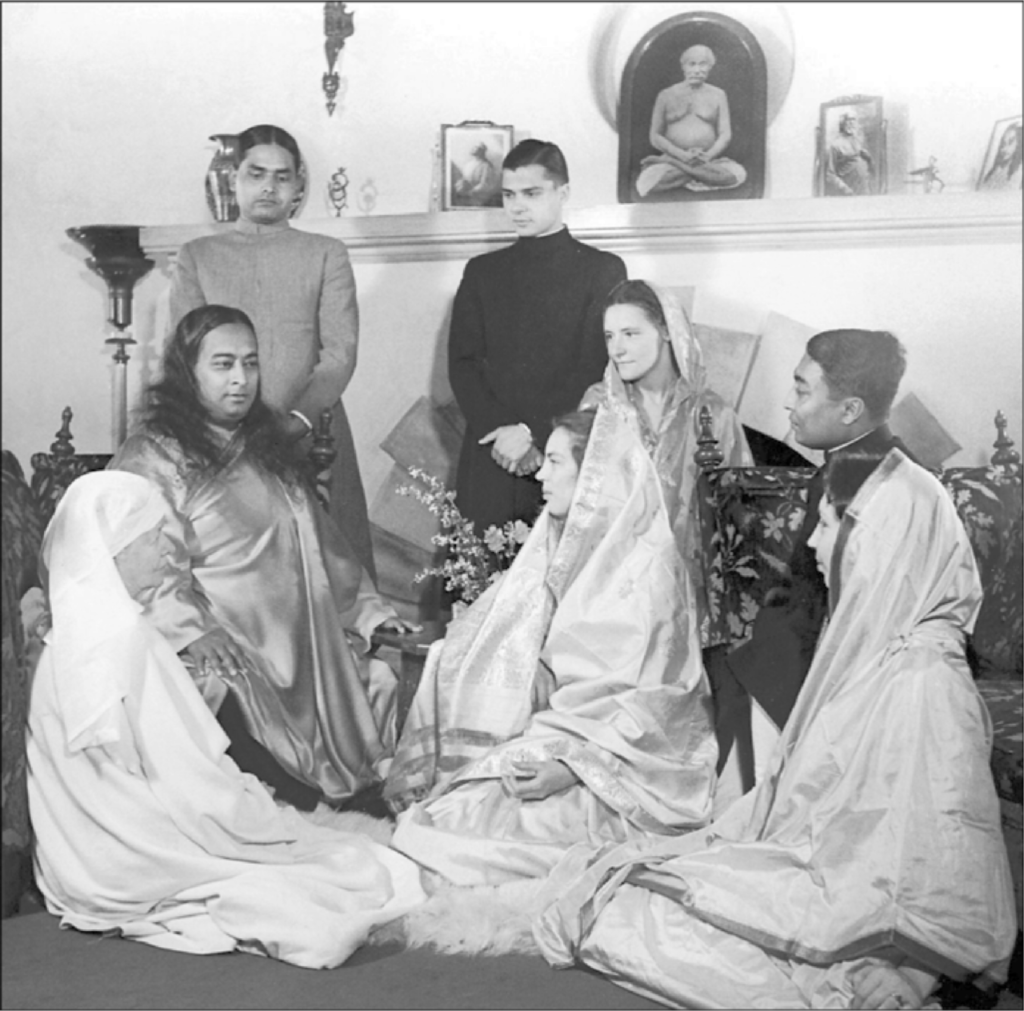
In his later years Yogananda asked disciples to edit the early articles: often earlier East-West editors had edited them poorly, had changed them, even added their own inspirations, while Yogananda had never glanced at them a second time. So they needed correction. However, the thought comes up: Yes, before Tara Mata came back in 1936, maybe earlier editors hadn’t done a great job. So re-editing was necessary. But after 1936?
SRF published a letter by Tara, dated 1937, in which she writes about her privilege to help with this wonderful book (referring to his scriptural interpretations), and “my end is pure grammar, arrangement.” In other words, she had done the editing job already. Back then in 1937 the Gita and Bible commentaries were still at the very beginning, and the Rubaiyat was just being born. The major portions of these works came later, and were under Tara’s editorial wings, as the editor of the magazine. And Yogananda was, as SRF writes, very happy with Tara’s work. One wonders, then, why further editing was deemed necessary later on.
Back to the magazines: In October 1937 the subtitle changed. The new name was Inner Culture – The Magazine of India. Was it a change of concept, to predominantly teach the Indian way of Self-realization? And indeed, soon afterwards Yogananda changed the subtitle again. From April 1938 he called his magazine Inner Culture – For Self-Realization… maybe the better choice.
All this happened not long after Yogananda’s return from his native land in late 1936. By the way, when Yogananda traveled through South-India, he met the illumined saint Ramana Maharishi. As Yogananda wrote, Ramana was a reader of the East-West magazines, and had a stack of them in his room. So was probably the Shankaracharya of Kanchipuram (one of the four main spiritual leaders in India), who had met Yogananda in 1935, and “followed his activities ever since.”
Surely many others in India were following their spiritual ambassador in the West. Indeed, back then, was there any other Indian saint living in America, successfully spreading the ancient yogic teachings? Yogananda’s success in America was big news for India, certainly. India was proud. That’s probably why Yogananda could unashamedly request India’s Prime Minister Jawaharlal Nehru in 1948, via cable telegram (published in the magazine): “Deeply request you save half of Gandhi’s ashes, some for India, some for America, to be buried beneath statues erected in two countries.” Nehru responded positively, and that’s why we find part of Mahatma Gandhi’s ashes buried at Lake Shrine. Later, in November 1949, Yogananda went to San Francisco to meet Nehru personally. It is interesting to see how Yogananda was at home with great saints, as well as with the world’s important politicians: he met the American president Calvin Coolidge, the President of Mexico Portes Gil, India’s Prime Minister Nehru, ambassadors, Lieutenant Governors, Consul Generals. And he was equally at home with great artists, inventors, business people, normal people, he met two Nobel Prize winners. In other words, he was a man of the world.
Oops, we are really still in the 30ies! So: Inner Culture was published monthly. Imagine the work involved.
The feeling and heartbeat of the magazine: more mature, more focused, more centered around Yogananda’s teachings. Central for sure were his interpretations of the Bible and the Bhagavad Gita.
~~~
The Forties
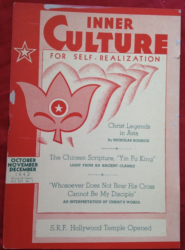
The 40ies saw many changes of the magazine. In July 1940 Yogananda decided to publish it quarterly. It might have been just too much work before.
In the early 40ies, Yogananda advertised in his magazine rooms at Mt Washington. One could rent them for a day or longer. This may show two things: Firstly rooms were still vacant, and therefore Yogananda’s band wasn’t very numerous (a fact which changed with the publication of his Autobiography in 1946). Secondly, it may show financial hardship, and/or wide-open arms for outside devotees.
About the rush that started in Yogananda’s life after his Autobiography of a Yogi had been published (from the magazine, Nov.-Dec. 1948): “The work has expanded beyond my imagination. Renunciates, in a steady stream, are joining our Headquarters Colony and our Encinitas Colony- and there is a long waiting line.”
The arrival of the Autobiography of a Yogi was certainly a pivotal event for Yogananda’s work, and so he urged readers of his magazine to “spread the message” by sharing with others their copy of the book, or by presenting copies to their friends. Wonderful feedback came streaming in, and Yogananda shared it through East-West.
Wait a moment! Why “East-West“? Hadn’t the name changed to Inner Culture a long time ago? Yes, but in July 1944, interestingly, Yogananda changed the magazine’s name back to East-West. The change lasted for only about four years, until Sept 1948. From then on the name changed to Self-Realization Magazine. It was still printed quarterly.
A typical index of the magazine during the 40ies (East-West, April, May, June 1945):
- An International Language, by A. Lavagnini
- My Easter Prayer, by Paramhansa Yogananda
- True Renunciation, by Hanumanprasad Poddar
- Attaining Freedom from Duty, Bhagavad Gita commentary by Paramhansa Yogananda
- To Divine Mother, poem by Kandhubhai Desai
- To Our Spiritual Father, poem by Sharon O’Neil
- Science in Ancient India, by Kumar Goshal
- Daily Deliberations for April, May, June, by Paramhansa Yogananda and many others
- Temple or Thieves Den?, Bible interpretations by Paramhansa Yogananda
- His Face in the Mirror, by Sri Bolanathji Maharaj
- Spheres of Science, New Vitamins
- Notes from the News (popular Hindu Dancers; Comparative Religion; Inspiration)
- International Fellowship (News from India; Science Transcends Boundaries; China-India handclasp; Protecting Minorities)
- Book Reviews by Virginia Scott (Letter from New Guinea; Your Kids and Mine; Life Out There)
- Directory of Centers
Articles on yoga postures started from the late 40ies on, and continued for many years.
From January 1949 onwards Yogananda gave a new burst of energy to his magazine, starting to publish it bimonthly, instead of quarterly.
A note about copyright: Yogananda’s magazines are in the public domain until Dec. 1942, free for all to use. Later magazines are under SRF’s wings.
For interested readers: If you want to read and study the whole set of the magazines, you can find them in the Library of Congress, Washington DC. The Stanford University Library has many, too. The British National Library in London has a few (shelfmark P.P.636.ctd). You may also order copies of the magazines from them via internet, or go and make copies yourself. Legally, of course, you can only copy, or order copies, for issues until Dec. 1942.
Here is the most typical prayer of Yogananda as it was printed in his magazine: “Heavenly Father, Jesus, Supreme Master Babaji, Great Master Lahiri Mahasaya, Master Sri Yukteswarji, Guru-preceptor, I bow to you all. May Thy love shine forever on the sanctuary of my devotion, and may I be able to awaken Thy Love in all hearts.”
The magazines’ general pulse and heartbeat during those years: Dynamic, joyful, and alive with new ideas.
~~~
The Fifties
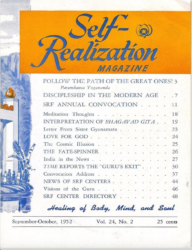
The magazine witnessed the two final years of Yogananda’s presence on this planet. The SRF environment was quite different then. Uniforms were not being used. Monks and nuns wore normal clothing during Yogananda’s lifetime. Imagine Daya Mata, Durga Ma, and all the others in informal clothes. “You don’t have to wear a uniform, robes, or saris, while I am here, that can come after I go to the Infinite,” Yogananda had frequently said (see Durga Mata’s book). “You’ll never be able to organize the work while Master is alive,” Gyanamata added.
In the Sept.-Oct. 1950 magazine, in the printed Lake Shrine dedication talk, Yogananda explains that his boys “wear American dress, and so do I. This robe is only for spiritual occasions. I do not emphasize dress… Our boys and girls dress as Americans, but their hearts are different.”
Rajarsi didn’t introduce uniforms during his presidency.
They were introduced in 1959, when Daya Mata returned from India. The sisters now began to wear elegant orange saris. The brothers received a simple, more Westernized outfit, also orange, and when ministering they wear the Western priest collar.
When Yogananda passed on, his magazine revealed divine timing: the last issue during Yogananda’s lifetime contained, amazingly, an article titled “The Final Experience.” It was the last in a series of his commentaries on the Bible that had been running continuously for twenty years. In this issue he expanded on the words: “And when Jesus had cried with a loud voice, he said, Father, into thy hands I commend my spirit: and having said thus, he gave up the ghost.” It appeared in the March 1952 issue, the exact time when Yogananda left for the higher planes.
Surprisingly, at that time the magazine still cost 25c, just like the very first issue 30 years earlier.
During Rajarsi’s presidency (1952-1955) not many changes can be observed in the magazine. The reason might be his increasing illness, or that he was quite happy with what his Master had established.
Daya Mata was elected president in 1955. After some time of her guidance, the magazine shows a few significant changes:
- Yogananda’s name and signature were changed to “Paramahansa,” rendering them correctly in Sanskrit, as it was later explained.
- Yogananda’s “Aims and Ideals” were modified, eliminating the world-brotherhood-colony ideal, which, so it was pointed out, Yogananda had abandoned.
- The altars and prayers were modified, adding Krishna, flipping Sri Yukteswar’s image, and switching Yogananda and Sri Yukteswar’s positions.
In the 50ies the magazine sold SRF travel altars. It is fun to see those original ones with five SRF Gurus. That altar arrangement was still publicly clarified (answering questions from students) in the magazine in Nov./Dec 1959: “Paramahansa Yogananda arranged himself the number and relative positions of the five pictures that show the line of SRF-YSS gurus.” Here it is:
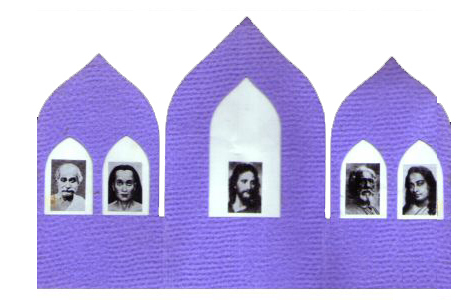
Do these changes in the magazine reflect what happened within SRF during that period? It seems so. Some disciples recount it was indeed a time of change within SRF:
- Everybody now took monastic vows. Yogananda’s monastic order started in 1931, but there were always devotees around at Mt. Washington and Encinitas who didn’t take the monastic vows, like Daya’s brother Richard Wright, who held high positions in SRF until 1941 (Board of Directors, in charge of offices and personnel at Mt. Washington, SRF treasurer); or Peggy Deitz, who was Yogananda’s driver, and came in 1949 to live at Mt. Washington. This new monastic setting was for example the reason why Reverend Bernard Cole left.
- All monks and nuns now received a monastic name. Yogananda had given only very few of them: Gyanamata, Durga Ma, Mataji, Rajarsi Janakananda; all other devotees kept their normal names. Daya Mata for example had been a monastic for over 20 years, but never received a monastic name from Yogananda. He called her Faye throughout.
- Kriyananda as a headmonk wrote a set of monastic discipleship lessons for the monks, and renunciant lessons were now held regularly. In general numerous rules were added to the monastic life.
- During that time Kriyananda was also the head of the SRF centers and wrote a set of guidelines for them. Later they were strengthened to rules.
- Monastic uniforms started.
Another interesting point of observation is the magazine’s “Directory of Centers.”
- In his various SRF centers, as one can read in the old magazines, Yogananda had appointed a “conducting teacher.”
- After Yogananda’s passing, in the later 50ies, that job was reduced to a few “Meditation counselors.”
- Still later, even the center’s “Meditation counselors” disappeared, as the magazine shows. Traveling monks alone became the teachers.
In the Nov/Dec 1959 magazine one finds an announcement that “Sister Daya” from now on was to be called “Sister Dayamata.” Later she became Daya Mata. Also all other lady-disciples who had known Yogananda personally were now named “Mata.” Monks however who had been with the Master remained a “Brother,” like all the others.
In that same magazine, in her article about the trip to India, Dayamata calls Brother Kriyananda respectfully “Kriyanandaji.” She writes that she and Kriyananda enjoyed long talks together, they lectured side by side, and she inserted his notes from their conversation with the Shankaracharya in her article for the magazine. They traveled for months together through India, with Dayamata’s sister, “Mataji,” and Sister Revati. Dayamata describes how she enjoyed Kriyananda and Karunananda (Devi Mukkherjee) playing soccer with enthusiasm and ability, and that she too tried to kick the ball, but got her feet entangled in her sari. Sweet to visualize.
Soon (in 1960) Brother Kriyananda was announced in the magazine as the new SRF vice-president, and as a member of the board of directors, who had been “close to Yogananda.” He already was in charge of the monks, of the centers and meditation groups, and was the main traveling Kriya minister.
A further interesting study of the magazine is to look at those ads which advertise books by non-SRF authors, throughout its history. It helps diagnose SRF’s heartbeat with the passing of time:
- Yogananda publicized spiritual books by other teachers, from outside of SRF. It seems a gesture of an open mind. A common feature in the 30ies and 40ies were book-reviews, discussing and recommending books of various authors.
- In the 40ies SRF advertised a list of 16 books written by Swami Premananda (formerly Bramachari Jotin, who joined Yogananda in the late 20ies, and had been educated in the Ranchi school), and another list of 11 books by Sri R.K. Das (another Indian whom Yogananda had called to teach on his behalf, who “founded” and lead the SRF center in Indianapolis.) These books were ordered not from Mt. Washington, but directly from Sri Das’ SRF center in Indianapolis, and from Premananda’s SRF center in Washington DC. It seems a gesture by Yogananda of empowering his teachers.
- A little jewel is found in East-West, April 1946, where a spiritual book of Mr. Dr. K. Samras, “formerly of the Self-Realization-Fellowship,” is advertised. He was still supported. This is seems sign of a mindset which says, “within or without the SRF organziation, you can offer a precious service.”
- After Yogananda’s passing, in the late 50ies, SRF sold apart from the regular SRF publications several important scriptures: Patanjali’s Yoga-Sutras, Shankaracharya’s Crest Jewel of Wisdom, the Ramayana and the Mahabharata, the Holy Bible. Also a vegetarian cookbook was sold, as well as Stories of Mukunda, a book about young Yogananda written by Kriyananda.
- From the 60ies onward, only SRF-books were sold. “The official organ of SRF” (as the magazine had always been called) showed definite symptoms of contraction.
Generally speaking: the heartbeat of the magazine at that point seems simple, spiritually very sincere, young and light. It also shows SRF’s direction toward a traditional Western monastic setup.
~~~
The Sixties
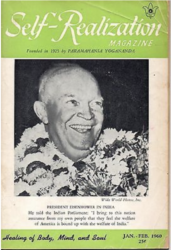
From about July 1961, the magazine became quarterly again (it had been bi-monthly).
From then on, for the next decades, very few changes can be observed. There were 64 pages, and the set-up remained practically undisturbed.
~~~
The Seventies
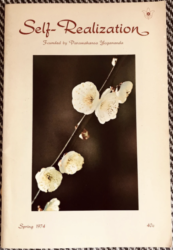
In 1970 the “Self-Realization Magazine” became simply “Self-Realization.”
From about January 1971 it remained a quarterly magazine, but was now divided into Spring, Summer, Fall, and Winter issues.
A letter from Daya Mata was included from the late 70ies onwards.
Otherwise the situation in the magazine remained calm. Vishnu, the Preserver, ruled.
~~~
The Eighties
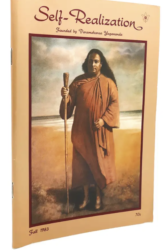
Not many waves can be observed. The magazine reveals a happy consolidation.
~~~
The Nineties
In the 90ies, judging from the magazines, something must have stirred SRF. The magazines, so steady and unmoving for decades, now began to wake up, began moving again. Brahma, the Creator, took charge.
In 1995, it seems, the SRF graphic designer-team changed. There is an obvious leap in quality. The design and layout has now become extremely professional and well-done. Before it had been beautiful too, but seemed more simple and homemade. All SRF magazines (and all SRF book covers) from now on were presented with the new SRF design and logo, and were obviously done by high-class professionals.
In 1999 once again fresh energy was poured into the magazine: SRF increased its number of pages from 64 to 80, adding articles of wider interest. Inside, for the first time, one color was used, instead of black /white. The price was raised from 75c to $2.
The basic feeling the new magazine conveys is: top professionalism. “How we present ourselves to the world is keenly important to us.”
~~~
2000
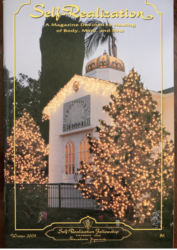
Here we include public publishing information which has been printed yearly in Self-Realization. These figures reveal to us the printed copies of the magazine throughout the years (and they give a rough insight into the size of SRF membership, as probably most sincere members subscribed to the magazine).
In Spring 1972 the “total paid circulation” was 11,899 – 13,482.
In Winter 1984 the “total paid circulation” was 21,488 – 21,957.
In Winter 1992, the “total paid and/or requested circulation” was 26,332 – 26,396.
In Winter 1995, the “Paid/Requested outside-county mail subscriptions” was 19,393 – 19,048; and “Paid in-county subscriptions: none.”
In Winter 2000, the “Paid/Requested outside-county mail subscriptions” was 19,069 – 20, 604; and “Paid in-county subscriptions: none.”
In Winter 2001 the “Paid/Requested outside-county mail subscriptions” was 18,250 – 18,199; “Paid in-county subscriptions: none.”
In Winter 2002 the “Paid/Requested outside-county mail subscriptions” was 17,494 – 17,890; “Paid in-county subscriptions: none.”
In Winter 2003, under “Paid/Requested outside-county mail subscriptions” was 16,629 – 16,548; and “Paid in-county subscriptions: none.”
In Winter 2004 was “Paid/Requested outside-county mail subscriptions” 15,157 – 14,634; “Paid in-county subscriptions: none.”
In Winter 2005 SRF stopped publishing this information. But the symptoms of the magazine were clear. Its heartbeat was getting a bit weaker. Doctors were called.
So things were stirred again, understandably. In 2005 a major change happened to the magazine: a CD was included, which presents a talk by an SRF minister. The price was therefore considerably raised from $2 to $6.
The new message of the magazine was: “It’s exclusively meant for you, our SRF members.” For who else would buy the ministers’ talks for $6? With this strategy, the numbers might well have dropped even more.
To be sure: the energy of the magazine remained certainly beautiful, inspiring, and sattwic. Much positive energy was flowing into it. Universality peeked through its pages again, here and there: for example in the Fall 2006 issue we find wisdom of various great Masters, like Ramakrishna, Vivekananda, Ram Das, etc. One could feel sincere devotees at work, trying to make the magazine fly with a breath of universality. But did they maybe find themselves bound by a lingering mindset of institutional centeredness, of a certain closedness?
One can imagine the Heavenly Doctor diagnosing: “In this world, we are all a little bit crazy. You in SRF are a little crazy too (don’t worry, it’s everyone!). So why don’t you mix with people differently crazy, to find out about your own little craziness? A self-referential attitude creates sickness. New fresh wind from outside would infuse your magazine with radiant health, with a young and creative spirit. Only in this way will it grow big again and reach countless souls.”
~~~
2010
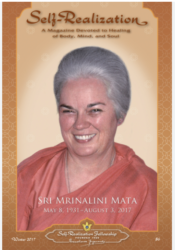
The magazine in those years remained beautiful, not modified since 2005. Substantial changes during Mrinalini Mata’s presidency in fact weren’t very likely, as she was over 80.
~~~
2020ies
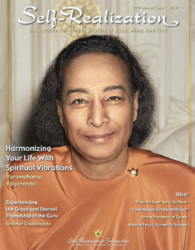
But under the new president Brother Chidananda the magazine was modernized and transformed. From 2021 it changed more toward the digital world: only one issue is now being printed each year. This is a huge change for the magazine, after almost exactly a century of existence, always offering several issues each year.
In exchange the readers can now enjoy new online features: those who subscribe for three years have access to an online library which contains lots of material from past issues, by Yogananda, Daya Mata, and others. In addition, they receive access for streaming the audio talks from SRF monastics, which earlier had been released as CDs along with the magazine. Plus the reader can now read the one yearly issue in digital form.
The specific SRF design which had been used for 26 years for magazines and books, is now abandoned.
~~~
So let’s observe what the future brings. As we have seen, there have been many changes in the magazine throughout the years, corrections, ups and downs. The magazine will certainly continue to evolve, and share with the attentive reader the current heartbeat within the monastic walls of SRF.

